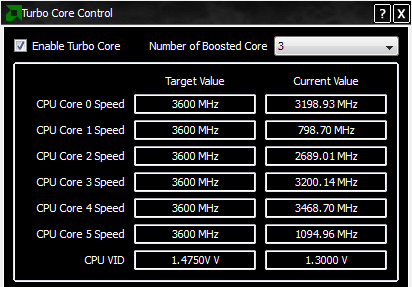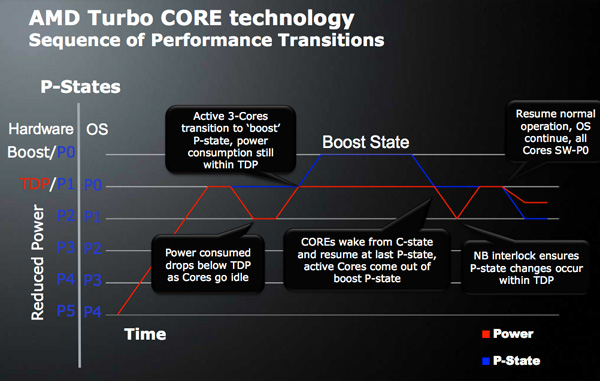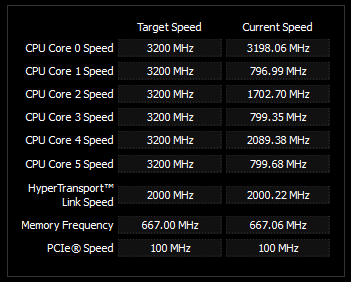AMD's Six-Core Phenom II X6 1090T & 1055T Reviewed
by Anand Lal Shimpi on April 27, 2010 12:26 AM EST- Posted in
- CPUs
- AMD
- Phenom II X6
AMD’s Turbo: It Works
In the Pentium 4 days Intel quickly discovered that there was a ceiling in terms of how much heat you could realistically dissipate in a standard desktop PC without resorting to more exotic cooling methods. Prior to the Pentium 4, desktop PCs saw generally rising TDPs for both CPUs and GPUs with little regard to maximum power consumption. It wasn’t until we started hitting physical limits of power consumption and heat dissipation that Intel (and AMD) imposed some limits.
High end desktop CPUs now spend their days bumping up against 125 - 140W limits. While mainstream CPUs are down at 65W. Mobile CPUs are generally below 35W. These TDP limits become a problem as you scale up clock speed or core count.
In homogenous multicore CPUs you’ve got a number of identical processor cores that together have to share the maximum TDP of the processor. If a single hypothetical 4GHz processor core hits 125W, then fitting two of them into the same TDP you have to run the cores at a lower clock speed. Say 3.6GHz. Want a quad-core version? Drop the clock speed again. Six cores? Now you’re probably down to 3.2GHz.
| Single Core | Dual Core | Quad Core | Hex Core |
 |
 |
 |
 |
 |
 |
 |
 |
This is fine if all of your applications are multithreaded and can use all available cores, but life is rarely so perfect. Instead you’ve got a mix of applications and workloads that’ll use anywhere from one to six cores. Browsing the web may only task one or two cores, gaming might use two or four and encoding a video can use all six. If you opt for a six core processor you get great encoding performance, but worse gaming and web browsing performance. Go for a dual core chip and you’ll run the simple things quickly, but suffer in encoding and gaming performance. There’s no winning.
With Nehalem, Intel introduced power gate transistors. Stick one of these in front of a supply voltage line to a core, turn it off and the entire core shuts off. In the past AMD and Intel only put gates in front of the clock signal going to a core (or blocks of a core), this would make sure the core remained inactive but it could still leak power - a problem that got worse with smaller transistor geometries. These power gate transistors however addressed both active and leakage power, an idle core could be almost completely shut off.
If you can take a single core out of the TDP equation, then with some extra logic (around 1M transistors on Nehalem) you can increase the frequency of the remaining cores until you run into TDP or other physical limitations. This is how Intel’s Turbo Boost technology works. Depending on how many cores are active and the amount of power they’re consuming a CPU with Intel’s Turbo Boost can run at up to some predefined frequency above its stock speed.

With Thuban, AMD introduces its own alternative called Turbo Core. The original Phenom processor had the ability to adjust the clock speed of each individual core. AMD disabled this functionality with the Phenom II to avoid some performance problems we ran into, but it’s back with Thuban.
If half (or more) of the CPU cores on a Thuban die are idle, Turbo Core does the following:
1) Decreases the clock speed of the idle cores down to as low as 800MHz.
2) Increases the voltage of all of the cores.
3) Increases the clock speed of the active cores up to 500MHz above their default clock speed.

The end result is the same as Intel’s Turbo Boost from a performance standpoint. Lightly threaded apps see a performance increase. Even heavily threaded workloads might have periods of time that are bound by the performance of a single thread - they benefit from AMD’s Turbo Core as well. In practice, Turbo Core appears to work. While I rarely saw the Phenom II X6 1090T hit 3.6GHz, I would see the occasional jump to 3.4GHz. As you can tell from the screenshot above, there's very little consistency between the cores and their operating frequencies - they all run as fast or as slow as they possibly can it seems.
| AMD's Turbo Core Benefit | |||||
| AMD Phenom II X6 1090T | Turbo Core Disabled | Turbo Core Enabled | Performance Increase | ||
| x264-HD 3.03 1st Pass | 71.4 fps | 74.5 fps | 4.3% | ||
| x264-HD 3.03 2nd Pass | 29.4 fps | 30.3 fps | 3.1% | ||
| Left 4 Dead | 117.3 fps | 127.2 fps | 8.4% | ||
| 7-zip Compression Test | 3069 KB/s | 3197 KB/s | 4.2% | ||
Turbo Core generally increased performance between 2 and 10% in our standard suite of tests. Given that the max clock speed increase on a Phenom II X6 1090T is 12.5%, that’s not a bad range of performance improvement. Intel’s CPUs stand to gain a bit more (and use less power) from turbo thanks to the fact that Lynnfield, Clarkdale, et al. will physically shut off idle cores rather than just underclock them.

I have noticed a few situations where performance in a benchmark was unexpectedly low with Turbo Core enabled. This could be an artifact of independent core clocking similar to what we saw in the Phenom days, however I saw no consistent issues in my time with the chip thus far.










168 Comments
View All Comments
Lolimaster - Tuesday, April 27, 2010 - link
Other reviews that are worth to see.www.bit-tech.net/hardware/cpus/2010/04/27/amd-phenom-ii-x6-1090t-black-edition/4
www.hexus.net/content/item.php?item=24332&page=8
Seems that only anand put Thubies as so so cpu.
Calin - Tuesday, April 27, 2010 - link
From Bit-tech review:Conclusion
Despite being an astonishing £600 cheaper than the exorbitantly-priced Intel Core i7-980X Extreme Edition, the X6 1090T BE still isn’t a very good buy
sciwizam - Tuesday, April 27, 2010 - link
TigerDirect seems to have $50 rebate on the 1055T.http://www.tigerdirect.com/applications/SearchTool...
If Bing Cashback is applicable, there's another 12% off.
sciwizam - Tuesday, April 27, 2010 - link
Correction: Bing Cashback site says 8-10% for TigerDirect.Roland00 - Tuesday, April 27, 2010 - link
There are two ways you can get cashback with Tiger direct1) If you look under cashback stores you get a lower cashback.
2) If you use the search bar and type in a key term you will get a different cashback, with TD the key term is "Tigerdirect" with this trick you will get 12.3% cashback
Roland00 - Tuesday, April 27, 2010 - link
Tigerdirect now has a $50 dollar mail in rebate on the 1090T BE, making the total 249 After Rebatehttp://www.tigerdirect.com/applications/SearchTool...
If you do bing cashback and actually search for tigerdirect you get 12.3% bing cash back.
$299.99-$36.89 (12.3% Bing Cash Back)-$50.00 (Mail in Rebate)=$213.10 after rebates and bing cash back
max347 - Tuesday, April 27, 2010 - link
Usually AT is my go to hw reviews, but I have to say the overclocking section doesnt even look like any effort was put into it. Its a BE part, and you dont review how well it tweaks? Other reviews on the net have this at 4ghz+, and do all the charts with the oc and non oc included.I think most people who by the BE part will not keep the stock cooler. I use a TRUE cu, though I realize mainstream might be something a little less. At least throw a zalman 9xxx on there and see what it can do with that. Benched at 4ghz, the 1090T is competitive right up to the 980x (stock), which I think gives people a little more info on how high they can "reach" with this cpu.
I am in no way an AMD fanboy, but the $300 price tag for this performance seems like a leap for AMD. It has always been in my mind price/performance rather than work/clock cycle or the like.
Anyway, Thanks for the review!
pjconoso - Tuesday, April 27, 2010 - link
In addition to the price, keeping the processor in the same socket is another plus to this processor.ViRGE - Tuesday, April 27, 2010 - link
Are those other reviews using a 32bit OS or a 64bit OS? The last time I checked, the Phenom/Athlon II series was still poorly overclocking in 64bit mode. If it's still happening then any overclocking results would vary wildly depending on the OS used.yankeeDDL - Tuesday, April 27, 2010 - link
I understand (and substantially agree with) the comments and conclusions regarding how the 6-cores Phenom compares against 2 and 4 core CPUs from Intel.I wonder though if these benchmarks are capturing the real benefits of 6 cores.
In my 'daily' use I have several programs running in background: virus-scan, instant messaging, music players, email clients, browsers (that regularly update RSS feeds) and sometimes also torrent clients. These all consume some CPU cycles, obviously.
With all these running in background, I wonder if the difference between a 2-core and a 6-core CPU will be more pronounced.
In other words: does it make sense to compare two multi-core CPU by running a single application at the time (albeit, possibly, a multi-threaded one)?